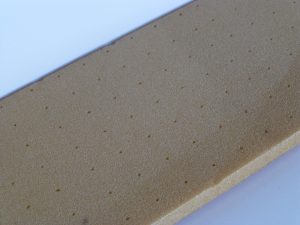Sandwich Panels are becoming increasingly popular in the construction of caravans and RVs in Australia. The main reasons include:
- Reduced weight
- Increased strength
- Faster construction
- Better insulation and thermal conductivity
- Reduced water ingress issues
A sandwich panel consists of 3 key components:
- A skin on each side
- A core in the centre
- A form of adhesive to join the above parts together
To understand why DIY composite panel A with a PVC core are the leading panels in the industry, we need to consider each of the above components in turn
1.The Skin
For this type of composite panel the ‘skins’ are hand-laid. The outside surface of the skin is a marine grade Gelcoat layer – available in gloss white – that is applied to the ‘table’ as a liquid. It is a pure product and does not contain fillers which means it will maintain its surface properties much better over the years – just take a look in a marina how well the yachts look!
Under the gelcoat is a layer of chopped strand mat (csm) – chopped strands of glass fibre laid randomly in the form of a mat. The thickness and specification of the csm will depend on the application of the panel in question.
A resin is used to bond the components together and fill the layer of chopped strand mat.
2.The Core
As the main component the core of a sandwich panel will largely determine it’s properties. Core types used in the industry include:
- Polystyrene – both Expanded (EPS) and Extruded (XPS)
- Polyurethane (PUR)
- Divinycell (PVC)
DIY composite panel A utilises a marine grade PVC perforated core which allows the sandwich panel to exhibit some exceptional characteristics in terms of:
Mechanical Properties
- The superior cores used have holes every 20mm (see image). During the process called vacuum infusion this network of holes allows the resin through the core so that it physically joins the skin on one side to the other skin every 20mm of the whole panel. Hence the panels are amongst the lightest in the industry at 7 kgs per m2 (approx) – since the superior cores allows the use of the same light laminate (instead of having to use a thicker (heavier) laminate with larger panel.
- Each panel is designed specifically for its application in the RV industry. Drawing on decades of experience in the marine industry each panel type has its unique design and has a proven track record in RVs over many years.
- Use of Polyester Resin is much stronger then conventional polymer adhesives used with other core types and is more stable at higher temperatures.
- As a result the panels enjoy superior compressive strength, shear strength and tensile strength characteristics
Our tests reveal these panels can withstand substantially higher forces without suffering any defects
- The Panels also display excellent elongation ability ie torsion and twist
An important characteristic for a product attached to a chassis that will be twisting and turning every day.
FST and High Temperature Properties
- FST stands for Fire Smoke and Toxicity testing – since we are likely to sleep inside our van the FST performance is worth considering. The PVC cores are not only fire retardant – they are fire extinguishing – they simply will not support fire.
- Divinycell PVC cores have a heat distortion temperature of 125 degrees C – our oven test showed some interesting results with other cores. You can relax in the knowledge there will not be any risk of delamination with Composite panels with a PVC core!
Thermal Properties
- The thermal conductivity will tell you how well a material will transmit thermal energy at a given temperature (in W/mK). Since it is the air that provides the ‘insulation’ and all the cores trap air – the thermal conductivity of most cores are very similiar. PVC has a value of 0.028 W/mK. With a DIY composite panel kit A you will not only be more comfortable in Australia’s extreme temperatures, but you will also save energy cooling or heating your ‘home away from home’.
Water vapour permeability
- The issue of water ingress in the caravan industry is huge. A sandwich panel that has ‘sucked up’ moisture vapour will provide poorer insulation values and be much heavier in weight.
- Whilst most panels are impervious to water when they are new, many cores will lose this quality and absorb water over time.
- PVC cores used by DIY Caravans have water vapour permeability values up to 10 times lower than some other cores and they will maintain this quality for many years.
3.The Form of adhesive
DIY composite panels with a PVC core are able to use a marine grade Polyester Resin to ‘bond’ the skins together instead of using a contact adhesive.
- During a process called ‘vacuum infusion’ the resin flows through the perforated core to physically join the skins together every 20mm. This contributes to the excellent physical properties.
- Alternative panel types are not able to use resin but use construction type adhesives which are less consistent at high temperatures. DIY has tested it composite panels with a PVC core in ovens at up to 98 degrees – with no detrimental effect.
In summary, both the materials used and the method of construction contribute to the superior properties of the DIY composite panels with the pvc core.







